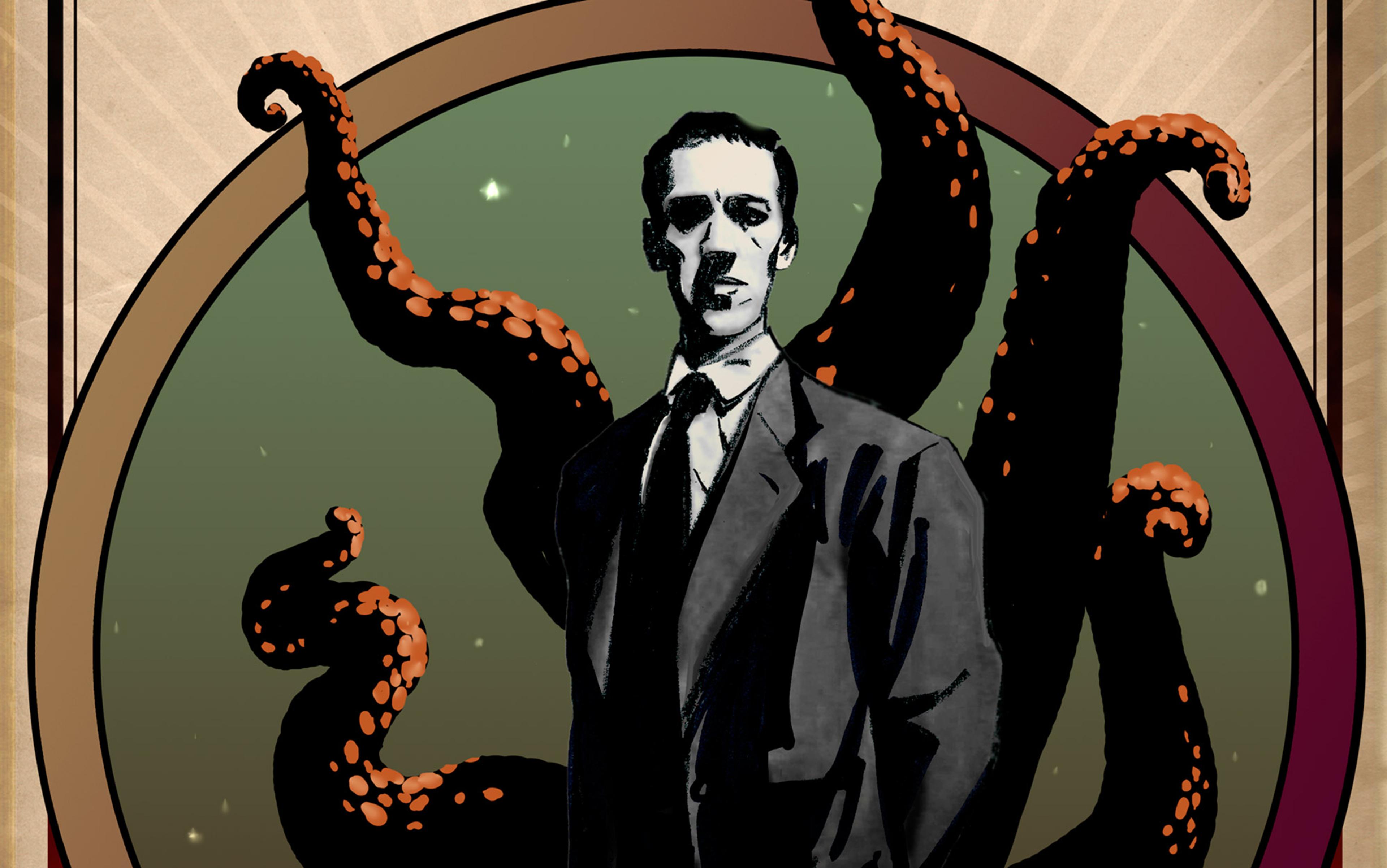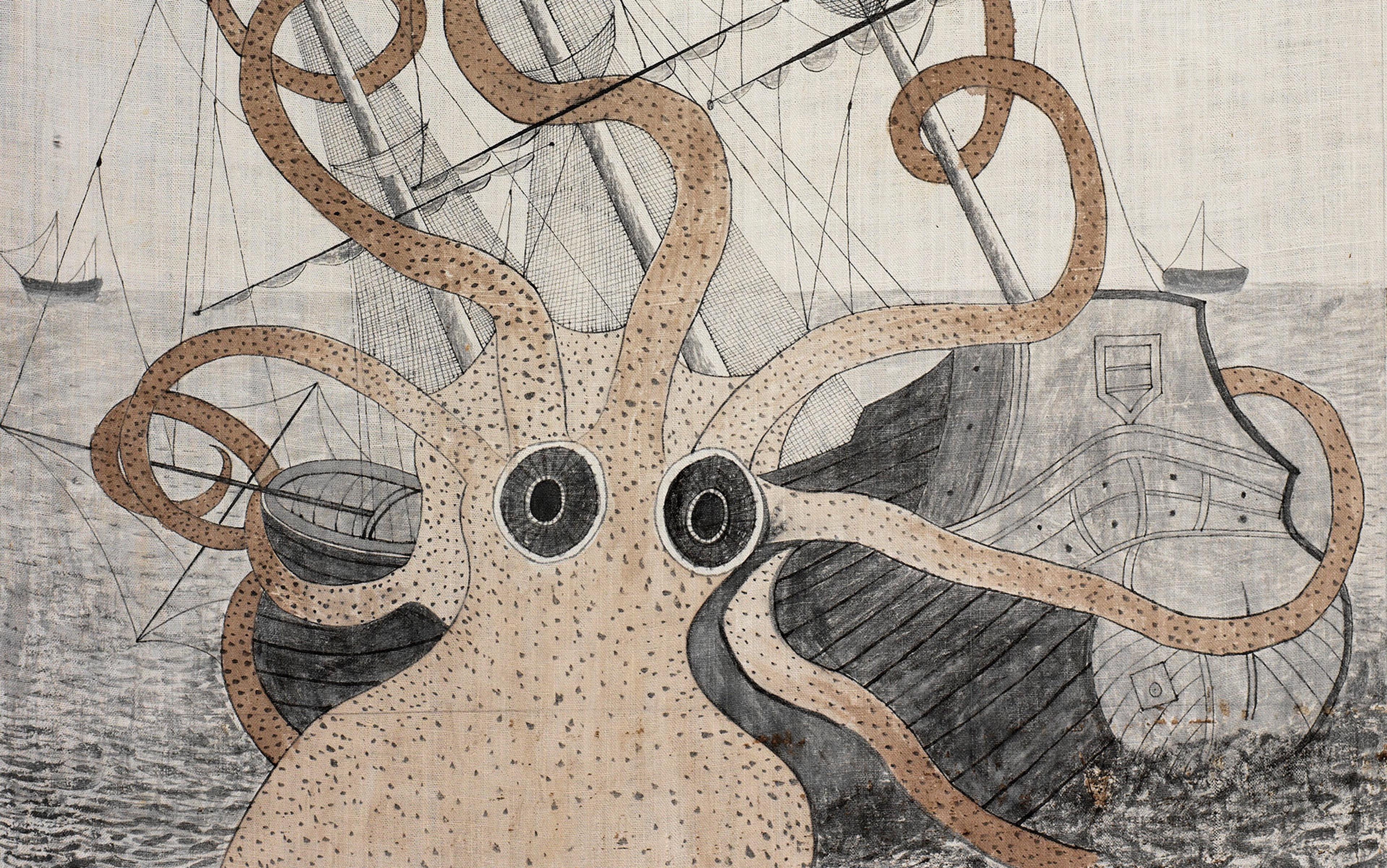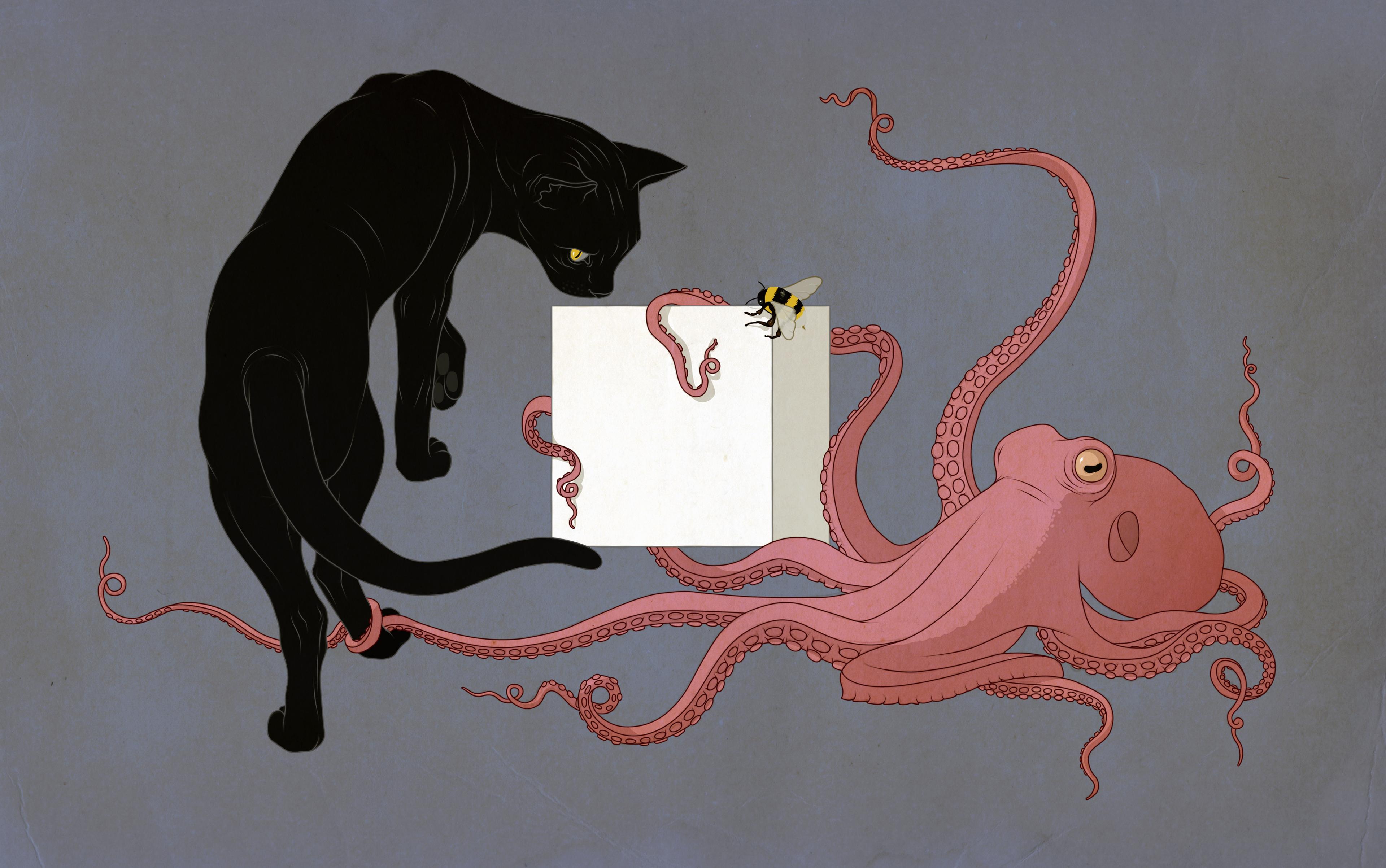Imagine looking down to see a severed hand scuttling toward you across the floor like a large, fleshy spider. Imagine a dog trotting up to you, amiably wagging its tail – but as it gets near you notice that, instead of a canine head, it has the head of an enormous green lizard. Imagine that you are walking through a garden where the vines all writhe like worms.
There’s no denying that each of these scenarios is frightening, but it’s not obvious why. There’s nothing puzzling about why being robbed at knifepoint, pursued by a pack of wolves, or trapped in a burning house are terrifying given the physical threat involved. The writhing vines, on the other hand, can’t hurt you though they make your blood run cold. As with the severed hand or the dog with the lizard head, you have the stuff of nightmares – creepy.
And creepiness – Unheimlichkeit, as Sigmund Freud called it – definitely stands apart from other kinds of fear. Human beings have been preoccupied with creepy beings such as monsters and demons since the beginning of recorded history, and probably long before. Even today in the developed world where science has banished the nightmarish beings that kept our ancestors awake at night, zombies, vampires and other menacing entities retain their grip on the human imagination in tales of horror, one of the most popular genres in film and TV.
Why the enduring fascination with creepiness? What lies at the core of this special form of dread? The psychologists Francis McAndrew and Sara Koehnke of Knox College in Illinois try to get at the essence in their paper ‘On the Nature of Creepiness’ (2016), where they propose that a person is creepy if we are uncertain about whether he or she is someone to fear, which leads to psychic paralysis. To test this idea, they conducted an online survey in which more than 1,300 respondents were asked to imagine that a trusted friend reported meeting a person whom they characterised as ‘creepy’. Participants were then asked to select characteristics that they imagined the hypothetical creepy person to possess, to rate the creepiness of a list of occupations, to name two creepy hobbies, and finally to evaluate the truth or falsity of 15 statements about the characteristics of creepy people.
The results of this survey are for the most part unsurprising. Participants pictured the creepy person standing inappropriately close to their friend, displaying a peculiar smile; having greasy or unkempt hair, bulging eyes, abnormally long fingers, very pale skin or bags under the eyes. The imagined creepy person wore dirty or peculiar clothes, often licked his or her lips, laughed unpredictably, and obsessively steered conversation towards a single topic, making it difficult for the friend to break it off. Clowns topped the list of creepy professions, followed by taxidermists, sex-shop owners and funeral directors.
When it came to hobbies, collecting dolls, insects, reptiles or body parts (such as teeth, fingernails and bones) were rated as especially creepy. Answers to the 15 questions revealed that creepiness was most often regarded as an innate characteristic of the person rather than merely a feature of their behaviour; that creepy people elicit fear or anxiety in others; and that people whom we regard as creepy can harbour sexual desires towards us (this might have to do with the fact that more than half of the respondents in the study were women, who mainly imagined that the creepy person in the vignette was a man).
The results suggested a core concept of creepiness: people whose behaviour or appearance deviated from the norm, making them unpredictable or possibly dangerous, triggered the so-called ‘creepiness detector’ – the intuitive sense that danger could be in the offing. Call this the ‘Threat Ambiguity Theory’ of creepiness, or TAT for short.
But the portent of physical danger needn’t be a necessary ingredient of creepiness, according to some researchers. This view was first explored by the German psychiatrist Ernst Jentsch in his groundbreaking essay ‘Zur Psychologie des Unheimlichen’ (1906), conventionally translated into English as ‘On the Psychology of the Uncanny’. But that fails to do the German justice. Uncanny things are anomalous, but not invariably unsettling or ominous. In most contexts, things described as Unheimlich are spine-chilling. They make your flesh crawl.
Like McAndrews and Koehnke, Jentsch held that Unheimlichkeit was the upshot of a kind of uncertainty leading to cognitive paralysis; but he did not think that paralysis was prompted by uncertainty about threat. Instead, he made the case that when we regard a thing as creepy it’s because we are uncertain about what kind of thing it is.
When we encounter something familiar, we immediately categorise it as such-and-such a kind of thing. When we encounter something novel, we often slot it into a pre-existing category. But there are occasions when we encounter things that resist categorisation. They seem to belong to two or more mutually exclusive categories. In such circumstances, we are suspended between alternatives. We don’t know what to make of the thing, because it violates our established conceptual norms. Jentsch argued that when this occurs it elicits a distinctive and disturbing feeling – the feeling of creepiness. Call this the ‘Categorical Ambiguity Theory’ of creepiness, or CAT.
the eyes are fixed and dead, the facial expression is immobile, and the skin has a peculiar, waxy texture
Jentsch’s most compelling example turns on uncertainty about whether a thing is animate or inanimate. ‘Among all the psychical uncertainties that can become a cause for the uncanny feeling to arise,’ he wrote, ‘there is one in particular that is able to develop a fairly regular, powerful and very general effect: namely, doubt as to whether an apparently living being really is animate and, conversely, doubt as to whether a lifeless object may not in fact be animate.’
Inanimate simulations of the human form that are almost indistinguishable from the genuine article can be extremely disturbing. Consider a waxwork figure – say, one that’s meant to represent President Barak Obama – so lifelike it would be easy to mistake it at a glance for the man himself. But there’s something not quite right about it: the eyes are fixed and dead, the facial expression is immobile, and the skin has a peculiar, waxy texture. This mix of characteristics causes the spectator to respond in a contradictory manner: as though it were a living, breathing human being and also as if it were an inanimate lump of matter. As long as she is unable to settle unequivocally on one or another of these inconsistent interpretations of the figure, she experiences it as creepy.
Jentsch’s theory of creepiness faded into obscurity until Masahiro Mori, then a professor of engineering at the Tokyo Institute of Technology, rediscovered it more than half a century later. Mori wrote a short but immensely influential article entitled ‘Bukimi No Tani Genshō’ (1970), which later appeared in English under the title ‘The Uncanny Valley’.
Mori predicted that, as robots become more and more human-looking, they also become more and more likeable to the humans who interact with them, but only up to a point. When androids are nearly indistinguishable from humans, a precipitous drop in their likability will occur. ‘In climbing toward the goal of making robots appear human,’ he wrote, ‘our affinity for them increases until we come to a valley which I call the uncanny [bukimi] valley.’ In an interview conducted more than 40 years later, Mori said that his speculations about the valley were guided by reflections on his own psychological responses: ‘Since I was a child,’ he remarked, ‘I have never liked looking at wax figures. They looked somewhat creepy to me.’
Mori’s insight resonates with experience. Robots such as Star Wars’ R2D2 and 3CPO are unambiguously non-human, and are cute rather than eerie, but the same cannot be said for Robin Williams’s benign but disturbing NDR-114 in the comedy Bicentennial Man (1999), the semi-anthropomorphic androids in Steven Spielberg’s AI (2001), the seductive Ava in Ex Machina (2015) or, striking a more sinister chord, the devil-doll Chucky in Child’s Play (1988) and its sequels.
As was the case with Jentsch’s Unheimlich, the conventional English translation of Mori’s bukimi as ‘uncanny’ doesn’t adequately capture the sense of the original. Something that is bukimi is not just strange or anomalous: it is eerie or creepy. So the so-called ‘uncanny valley’ is better understood as the valley of creepiness.
This valley of creepiness does not pose a problem only for the designers of androids. It also presents a hurdle for animators looking to create realistic simulations of human actors. As computer-generated animations become increasingly realistic, they also become increasingly bukimi. One striking example is the animated film The Polar Express (2004), the first motion-capture film, which ‘samples’ an actor’s movements before generating them digitally. Right after this movie’s release, a number of reviewers remarked that they found it strangely disturbing. ‘There’s something eerie and dead about these children’s eyes, making them resemble those evil, stoic kids of the 1960 horror flick Village of the Damned,’ wrote David Germain of the Associated Press.
Zombies and vampires are cognitively threatening because they straddle the divide between the living and the dead
Comparing The Polar Express with Village of the Damned points to an important dimension of creepiness: a connection to the monsters that haunt cinematic and literary horror fiction. Monsters are, by definition, malevolent creatures that violate the natural order of things. Monsters are not merely terrifying. They are horrifying – because they are also creepy.
There is nowadays a burgeoning literature devoted to the study of monsters, but a single strand inspired by the work of the anthropologist Mary Douglas – in particular, her celebrated book Purity and Danger (1966) – is relevant here. Douglas points out that every culture possesses some conception of the natural order of things – a system of categories to make sense of the world. Any such system of meaning is inevitably confronted with anomalies that don’t fit into the scheme. When anomalies appear to transgress the natural order, they are branded as abominations. Douglas’s favoured examples concern food taboos. If, like the ancient Hebrews, you believe that mammals are naturally divided into those that have cloven hoofs and chew their cud and those that lack these traits, it turns out that pigs, which have cloven hoofs but do not chew their cud, do violence to the taxonomy. Like other interstitial beings, pigs are felt to be impure or unclean in a sense that goes well beyond merely physical dirtiness. They are, so to speak, metaphysically polluted.
What has all this got to do with monsters?
The philosopher Noël Carroll at the City University of New York shows that Douglas’s theory of impurity provides a powerful framework for understanding monsters and what makes them so disturbing. In his book The Philosophy of Horror (1990), he points out that for something to be a monster it has to satisfy two criteria: it must be both physically and, most importantly, cognitively threatening. Something that’s physically threatening might harm you, cause you pain or kill you. But something that’s cognitively threatening is impure in Douglas’s sense. It’s something that, by its very nature, does violence to the socially entrenched categories that we use to make sense of the world. Zombies and vampires are cognitively threatening because they straddle the divide between the living and the dead. The horrific predators in Ridley Scott’s film Alien (1979) fuse human and non-human attributes into a single contradictory whole. Others, such as Linda Blair’s character in The Exorcist (1973), are simultaneously person and demon. There are a multitude of variations on the theme in both popular and highbrow culture.
TAT or CAT? Does the feeling of creepiness stem from uncertainty about physical threat, espoused by the Threat Ambiguity Theory? Or does the chill set in only with uncertainty about the kind of thing to which the novel object belongs – the Categorical Ambiguity Thesis? The contributions by Jentsch, Mori, Douglas and Carroll all lend credence to CAT, but as appealing as CAT might appear, it is not entirely satisfactory. Consider categorically ambiguous artifacts – for example, an object that might be either a coffeemaker or a food processor. Such a device would unlikely repel anybody. In fact, I suspect that most people would find it rather attractive.
This suggests an important distinction between our way of thinking about things such as coffeemakers and things such as monsters. Perhaps the distinction lies in whether the thing violates the natural order or not. Because items such as coffeemakers are non-natural, they’re not candidates for being unnatural.
But even this fix won’t work, because some natural categories are immune from the creepiness effect. Chemical elements such as gold and silver are paradigmatic natural kinds, but ambiguity about whether a piece of jewellery is made of silver or gold doesn’t elicit a chill.
So, let’s try again.
Reviewing the examples of categorically ambiguous creepiness that I have described so far, it’s striking that they all involve animals – human animals, non-human animals, or both. A creepy creature might combine the human and non-human (a crawling hand), the animal and non-animal (vines that writhe like worms), or distinct sorts of non-human animal (a dog-lizard).
Categorically ambiguous animals pull our minds in two directions at once, and this cognitive paralysis generates creepiness
A phenomenon called ‘psychological essentialism’ throws light on why animals play such a prominent role. Since the late 1980s, a growing body of psychological research has shown that human beings are inclined to think of every member of an animal species as sharing a deep feature or ‘essence’ that only members of that species possess; possessing the essence is what makes it the case that an animal is a member of its species. What makes a dog a dog is its possession of the dog essence; what makes a porcupine a porcupine is its possession of the porcupine essence, and what makes a being human is the possession of the human essence.
It goes without saying that these essentialist assumptions are relics of a pre-Darwinian worldview, with no scientific justification. Yet essentialism persists as a psychological tendency or ‘folk theory’ that is so powerful that even those who know better – biologists and philosophers of biology – very easily slip into it. Psychological essentialism describes a very basic conceptual framework that we intuitively use to make sense of the natural world. It’s important to notice that we don’t attribute essences to artifacts (there’s no deep fact about a coffeemaker that makes it a coffeemaker), and although scientists and philosophers attribute essences to silver and gold (the possession of atomic numbers 47 and 79 respectively), this is scientific or philosophical essentialism rather than essentialism of the gut-level psychological kind. Psychological essentialism is especially focused on the domain of living things.
Now, here’s the kicker, the real key to creepiness: essences don’t come in degrees. It’s part of the notion of essences that if a thing possesses an essence, it possesses it completely. In our ordinary, pre-theoretical ways of cognising animals, if we think of something as a dog, we are inclined to think of it as completely a dog, and if we think of something as a lizard, we are inclined to think of it as completely a lizard. Now, consider the example of a dog with a lizard’s head. According to the implicit logic of essentialism, such a creature must be completely a dog and completely a lizard. But that’s impossible, because each of these excludes the other. It’s because we essentialise them that categorically ambiguous animals pull our minds in two directions at once, rather than causing us to take a middle path, and this cognitive paralysis is what generates the sensation of creepiness.
Before concluding this excursion, let’s contextualise the theories, TAT and CAT – they both play a role. TAT advocates are right to say that feelings of creepiness involve a sense of looming threat, but seemingly wrong in thinking of this as a physical threat. Notice that McAndrews and Koehnke offered TAT as an explanation of what it is that makes people creepy – it’s not a theory of monsters, wax simulacra, crawling hands or lizard-dogs – the sorts of things that CAT theorists have been anxious to understand. In fact, CAT covers most, if not all, of the phenomena that TAT explains, plus a great deal more.
TAT researchers point to creepy professions – funeral directors, to name one. A profession involving corpses, they suggest, arouses the suspicion that such people might be dangerous – a hypothesis that, on the face of it, does not seem plausible. Drawing on the work of CAT theorists, a different and, I think, more satisfying explanation is in the offing. As Jentsch pointed out, corpses are experienced as Unheimlich because we tend to see them simultaneously as persons (the ‘dear departed’) and as cold slabs of inanimate flesh. It might be that funeral directors are sometimes regarded as creepy because they have been polluted by contact with the Unheimlich dead.
Clowns were rated the creepiest profession, but why? It could be that, like waxwork figures and humanoid robots, clowns have attributes that belie their humanity. People wearing masks – especially full-faced masks with a fixed facial expression – are often seen as creepy for much the same reason (think of the über-creepy Michael Myers in John Carpenter’s 1978 film Halloween) – as are people with a mask-like appearance from cosmetic surgery gone awry.
It is not for nothing that dehumanised people are characterised as monsters and demons
Certain forms of disability or disfigurement also elicit the creepiness response, arguably because the disabled or disfigured person seems to embody both human and non-human attributes. The term teratology (literally, ‘monsterology’) refers both to the medical study of developmental pathologies and to the study of fictional or mythological monsters. It is implausible that disabled people are seen as potential threats, but possible that they are seen, at least unconsciously, as categorically ambiguous, a hybrid of human and non-human kinds.
There is even a body of psychological research showing that people tend to partition the social world into human kinds, and to imagine that these kinds are defined by essences – exactly as we do in the case of biological species. Gender is a prime example. In many cultures, including our own, it is assumed that people are neatly divided into two distinct genders, and also assumed that what makes a person a man or a woman, a boy or a girl, lies in some deep fact about them – a gender essence. In cultures where genders are rigidly fixed, individuals who deviate from these norms are often regarded as creepy, contaminating and impure.
Likewise, in societies with entrenched racial divisions, those who transgress the boundary between dominant and subordinate races are experienced as affronts to the natural order and are subject to discrimination, oppression, or outright violence. Members of dehumanised populations, such as Jews in Nazi Germany and African Americans in Jim Crow America, are judged creepy by virtue of their supposed status as human-looking vermin or apes. It is not for nothing that dehumanised people are often characterised as monsters, demons and the like.
Future studies will decide whether creepiness is always a matter of categorical ambiguity, as I have suggested, or whether threat ambiguity also plays a role. Whatever the outcome, the study of creepiness is likely to have far-reaching implications – not only for robotics, animation technology and blockbuster films, but also in preventing and combatting bullying, and securing social justice and human rights around the world.






